Early Office Museum
Antique Office Interior Photographs
~ 1880-1889 ~
When no date is provided in the Description column below, we do not know
the date of the image or photograph.
We have placed undated images and photographs in their likely chronological
order.
If the source in the right-hand column is anything other than "Early Office
Museum Archives,"
we do not have the ability to grant permission for use or to provide a high
resolution image.
| Click Image to Enlarge | Description | Source |
 |
Two men in an office, stereoview by George Wainwright Hennigar (1832-1910), Middleton, CT. Photo includes a map of New England, gas ceiling and desk lights, a lion head seal press, and a barometric ink stand that was patented in 1861-64. George Hennigar operated the Hennigar Studio from 1861 until his retirement in 1890, when he turned the business over to his sons, Morton and Howard, who renamed the studio Hennigar Bros. The gas used for illumination was produced from coal or oil. | Early Office Museum Archives. Information about the photographer provided by John Hennigar. |
 |
"The Marquis of Lorne in His Private Office at Rideau Hall," Ottawa, Ontario, Canada, 1880. The Marquis of Lorne (1845-1914), who was a commoner, married Princess Louise, a daughter of Queen Victoria, in 1871 and was Governor-General of Canada during 1878-83. | Canadian Illustrated News, Feb. 7, 1880. Library and Archives Canada. |
| "First Maccabee Office 1881." The Knights of the Maccabees was a fraternal and benevolent society founded in London, Ontario, Canada, in 1878. A substantial minority of its membership was in Michigan. The society provided life and disability insurance to ordinary citizens, provided they were white and did not make, sell, or consume alcohol. The fraternal aspect of the organization ended in 1962, leaving an insurance company. | Early Office Museum Archives |
|
| Picture coming. | "Western Union Operating Room, New York, 195 Broadway, in 1881." | National Museum of American History, Smithsonian Institution, Washington, D.C. |
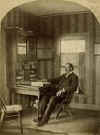 |
Lawyer in Office, Minnesota, stereoview, 1882. | Private collection |
 |
Lost Property Office, Metropolitan Police Department, Scotland Yard, London, England, 1883. | London Illustrated News, 1883. |
 |
Convict Office, Scotland Yard, London, England, 1883. | London Illustrated News, 1883 |
 |
U.S. bank clearing house, 1883. The men standing in line are specie clerks. The men sitting are settling clerks. Howe and Powers report that the main exchange room of a bank clearing house contained a settling counter, which took the form of an oblong ring. Each bank in the city had a space along the settling counter, with a chair inside the ring. "Each bank sends to the clearing house two clerks, a settling clerk and a specie clerk. The specie clerk brings a satchel containing drafts and checks to be delivered to other banks. Each settling clerk takes his place [seated] on the inside of the [settling] counter, and his mate the specie clerk [takes his place standing] opposite him on the outside of the settling counter. The manager taps his bell, and each specie clerk moves one step forward, [so that he is] opposite the next settling clerk. [The specie clerk] delivers the package of checks [written by customers of the bank for which the settling clerk works] over the counter and with it also his specie clerk's statement. The settling clerk compares the amount of the list on the package with the amount set down in the specie clerk's statement opposite the name of his bank, and if they agree he signs his name opposite the amount as a receipt. This same act is performed simultaneously by every settling clerk with military precision, and then the specie clerks take another step forward, all moving at once." | G. L. Howe and O. M. Powers, The Secrets of Success in Business, 1883. |
 |
"Interior View of the First National Bank, Chicago," IL, 1883. | G. L. Howe and O. M. Powers, The Secrets of Success in Business, 1883, p. 398. |
 |
"Interior View of the New York Office of R. G. Dun & Co's Mercantile Agency," New York, NY, 1883. Mercantile agencies were credit reporting services. They evaluated the credit-worthiness of businesses that were potential borrowers. The revenues of mercantile agencies were derived mainly from annual subscriptions purchased by merchants and firms that gave credit and made loans. Founded as the Mercantile Agency in 1841, R. G. Dun & Co. was the leading U.S. credit reporting agency during the second half of the 19th century. The company also provided other types of commercial information to subscribers. | G. L. Howe and O. M. Powers, The Secrets of Success in Business, 1883, p. 386. |
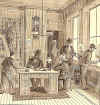 |
Stock or commodity broker's office with two ticker machines, 1883. The lighting fixtures use coal gas, and a gas line runs from the ceiling lamp to the desk lamp. | G. L. Howe and O. M. Powers, The Secrets of Success in Business, 1883. |
 |
Two men in office with desk, 1883. | G. L. Howe and O. M. Powers, The Secrets of Success in Business, 1883. |
| Office with (from left) letter copying press, large book-keeper's desk, and desk in the style of Wooton and Moore, 1883. | G. L. Howe and O. M. Powers, The Secrets of Success in Business, 1883, p. 85. | |
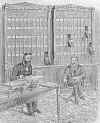 |
Mr. Kimball's Room, Internal Revenue Office, US Treasury Department, Washington, DC, 1884. The document file cabinets were supplied by National Office Furniture. | Catalogue, National Office Furniture, M.J Wine, Sole Proprietor, Washington, DC, 1884, in Early Office Museum Archives. |
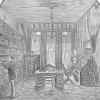 |
General Business Office, Bryant & Stratton Commercial School, Boston, MA, 1884. There is a roll-top desk, a safe, and gas lighting. "No stoves are allowed to be used in the building, or lights of any kind except city gas." | Twenty-Fourth Annual Prospectus of the Bryant & Stratton Commercial School, Boston, MA, 1884, pp. 28, A9. In Early Office Museum Archives |
 |
Office image from the catalog of a supplier of filing boxes and cabinets, 1884. | Catalogue, National Office Furniture, M.J Wine, Sole Proprietor, Washington, DC, 1884, in Early Office Museum Archives. |
 |
Interior of Gordon Edward Corbould's law office, New Westminster, British Columbia, Canada, c. 1885. Date estimated by NWPL. Corbould (1847-1926) was a lawyer from Toronto, Ontario, who began working in British Columbia in 1880, began practicing law in New Westminster in 1882, and was a member of the Canadian House of Commons during 1890-96. Photo shows electric light, lion head seal press, pen rack, and pigeon hole case on wall. | New Westminster
Public Library, New Westminster, BC, Canada, Accession No. 2912. |
 |
Governor's Room, Minnesota State Capitol, St. Paul, MN, c. 1885. Date estimated by MHS. Minnesota became a state in 1858. Photo includes a Remington No. 2 or No. 4 typewriter. | Minnesota Historical Society, Loc. no. FM6.121 p1, pf046008 |
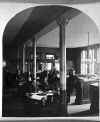 |
Shipping department, possibly at C. A. Pillsbury Co., Minnesota, MN, c. 1885. Date estimated by MHS. In 1869 Charles A. Pillsbury (1842-1899) borrowed money to buy a one-third interest in a Minneapolis flour mill, which was renamed the C. A. Pillsbury Company in 1871. By 1886, the company was the largest flour milling company in the world. | Minnesota Historical Society, pf027066, Loc. no. HF3 r37 |
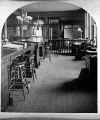 |
Office interior, possibly at C. A. Pillsbury Co., Minnesota, MN, c. 1885. Date estimated by MHS. Photo includes high stools at slant top desks and a cuspidor. There is a Remington typewriter on the desk at the right rear. | Minnesota Historical Society, pf027065, Loc. no. HF3 r36 |
 |
Office interior, possibly at C. A. Pillsbury Co., Minneapolis, MN, c. 1885. Date estimated by MHS. | Minnesota Historical Society, pf067694, Loc. no. HF3 r32 |
 |
Office interior, possibly at C. A. Pillsbury Co., Minneapolis, MN, c. 1885. Date estimated by MHS. | Minnesota Historical Society, pf121285, Loc. no. HF3 r31 |
 |
Office interior, possibly at C. A. Pillsbury Co., Minneapolis, MN, c. 1885. Date estimated by MHS. | Minnesota Historical Society, pf121284, Loc no. HF3 r33 |
 |
Office interior, possibly at C. A. Pillsbury Co., Minneapolis, MN, c. 1885. Date estimated by MHS. | Minnesota Historical Society, pf121283, Loc. no. HF3 r34 |
 |
Office interior, possibly at C. A. Pillsbury Co., Minneapolis, MN, c. 1885. Date estimated by MHS. | Minnesota Historical Society, pf121282, Loc. no. HF3 r35 |
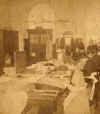 |
"Pension Office--Employees at Work, Washington, DC," Popular Series stereoview. | Early Office Museum Archives |
 |
"Corner in Office, H. M. Deal," Bucyrus, OH. The contents of this office indicate that the photograph was taken in 1880 or during the 1880s. The office contains a Caligraph typewriter, which was introduced in 1880. The office also contains a safe, a desk, a cabinet letter file, two postal scales, and a dating stamp of types that were available by 1880. The safe was made by Diebold & Kienzle of Canton, OH. Diebold & Kienzle was in business at least from the 1870s to 1887. H. M. Deal (b. 1854), the son of Martin Deal, worked in his father's agricultural machinery manufacturing business from 1876 until at least 1881. During 1876-78 the younger Deal was an assistant clerk; he became general manage in 1878. In 1881, the company was "making thirty-six different styles of machines for cleaning grain. Mr. Deal is a partner in Deal's Improved Wheat Heater, which has proved lucrative, and is also the manufacturer and sole proprietor of Deal's Corundum Polisher, a tool for cutting, leveling and polishing the furrows and face of millstones." (History of Crawford County and Ohio Biographical Sketches, 1881, p. 731) H. M. Deal was active in the First Methodist Episcopal Church in the late 1880s and in the Republican League in the early 1890s. | Early Office Museum Archives |
| Office, Kidder, Peabody & Co. Kidder, Peabody, a banking and investment house, was founded as a banking company in 1865 and existed until 1994. The photograph shows electric lighting. | Early Office Museum Archives |
|
 |
Office with eight women, three men, and three hanging kerosene lamps. There are no electric lights or telephones. Judging from the clothing, this office was not in the US; it may have been in continental Europe. | Early Office Museum Archives |
 |
Office of the Philadelphia and Reading Railway Co., Pier B Grain Elevator, Philadelphia, PA. There are three kerosene lamps and no electric lights in this office. On the desk is a ribbon dating/canceling machine; we have not previously seen this particular model or an advertisement for it, but many models were introduced between 1865 and the late 1870s. "Pier B, Port Richmond (above Cambria Street), owned by the Philadelphia & Reading Railway Company. Used by foreign, coastwise and river steamers carrying grain; 140' wide x 645' long; capacity, 1,500,000 bushels; four tracks, capacity 40 cars." (Port of Philadelphia: Its Facilities and Advantages, Harrisburg, PA, 1914) | Early Office Museum Archives |
 |
Thomas M. O'Brien, notary public, at his Wooton desk. | Early Office Museum Archives |
| Telephone switchboard operator (left) and telegraph operator, telephone and telegraph office, Arts and Industries Building, Smithsonian Institution, Washington, DC, 1886. On the wall is an advertisement for the Baltimore & Ohio Telegraph Co. The telephone and telegraph office was located in the Arts and Industries Building from the time the building opened in 1881. | Smithsonian Institution Archives, Image 3677 | |
 |
Large office portrait with thirty men and two women. Gas lighting, Remington typewriter, and McGill paper fastener press (model introduced by 1878) under man's hand in center of image. | Available from Ron Beck www.centuryimages.com |
 |
"Main Office, Rear View," photogravure, Photo-Views of the Connecticut Fire Insurance Company's Home Office, Hartford, Conn., 1887. The company was incorporated in 1850 and became one of the largest fire insurance companies in the U.S. Photo includes roll-top desks, high stools at slant top desks, and an American Dating Stamp (patented 1871-76). The photograph is one of several of offices in the same building taken in 1886. The artificial lighting in the offices was gas, not electric, and no telephones are visible. | Photo-Views of the Connecticut Fire Insurance Company's Home Office, Hartford, Conn., 1887, in Early Office Museum Archives |
| "Stenographer's Room," photogravure, Photo-Views of the Connecticut Fire Insurance Company's Home Office, Hartford, Conn., 1887. Photo taken in 1886 includes typewriter stands with two Remington machines. Because the platens appear to have large diameters and no shift springs are visible, the Remingtons are likely to be No. 4's, which typed upper case letters only, rather than No. 2's, which typed both upper and lower case letters. | Photo-Views of the Connecticut Fire Insurance Company's Home Office, Hartford, Conn., 1887, in Early Office Museum Archives | |
| Click on link at right to see photo. (Click on thumbnail to see full-size image.) When finished, click the "Back" button on your browser to return here. | "Milwaukee General Office of the Chicago, Milwaukee & St. Paul Railway Co.," Milwaukee, WI, 1887. | Wisconsin Historical Society, Wisconsin Historical Images, No. 4506. NEED TO RECONNECT LINK. |
 |
Head Office, A. & F. Pears Ltd., London, England. The building was completed in 1888. Andrew Pears began selling Pears transparent soap in London, England, in 1789. His soap company became A. & F. Pears Ltd. in 1835. | National Monuments Record, English Heritage. |
| Office, Riverside Press, Cambridge, MA. The Riverside Press was founded along the Charles River in 1852. The Riverside Publishing Co. is a wholly owned subsidiary of Houghton Mifflin Harcourt. | Private collection | |
| Main Operating Room of the Western Union Telegraph Company, New York, NY, 1889. Western Union was formed in 1856 through a merger of telegraph companies, and it dominated the telegraph industry in the U.S. Western Union ceased to offer telegraph service in 2006. | Scribner's Magazine, 1889. In Early Office Museum Archives. | |
 |
Office of Leonard Moody Real
Estate and Insurance, Brooklyn, NY.
This office has a letter copying press, gas lighting, and a wall telephone. The man on the right is likely to be Leonard Moody (1839-1905); his appearance is very similar to that of the man in a portrait of Moody on the wall. Moody appears to be about 50 years old in the photo to the left; if he is 50, then the photo was taken in 1889. Moody was born and had numerous relatives in the farming community of East Pittston, ME. After serving in the Union Army during the Civil War, Moody moved to Brooklyn, NY, in 1869. He founded his real estate company in the 1870s. He is listed in an 1873 Brooklyn directory as a real estate and insurance broker and an agent for coal and wood. His obituary reported that Moody was "the leading real estate broker in Brooklyn." In 1889 Moody was a founder of the Montauk Club of Brooklyn, which continues as a private social club in a portion of its original four-story Venetian Gothic building; the rest of the building has been converted to condos. In 1890, Moody built a 34-room Queen Anne style mansion in East Pittston as a summer home. He named it "Konig's Villa." ("koenig" is German for "king") Two years prior to Moody's death, a portion of the mansion was opened as "a first class boarding house for summer boarders." In 1910, five years after Moody's death, his company closed because it could not sell its real estate assets in order to pay its debts. In 2013 the Moody Mansion was being renovated and contained "an ice cream and hotdog joint." |
Early Office Museum Archives |
Photographs are copyrighted. All rights are reserved by the copyright holder, the owner of the photograph, and the Early Office Museum.